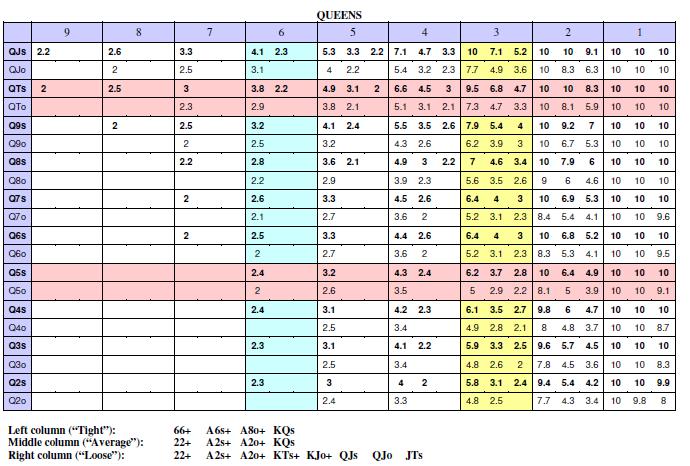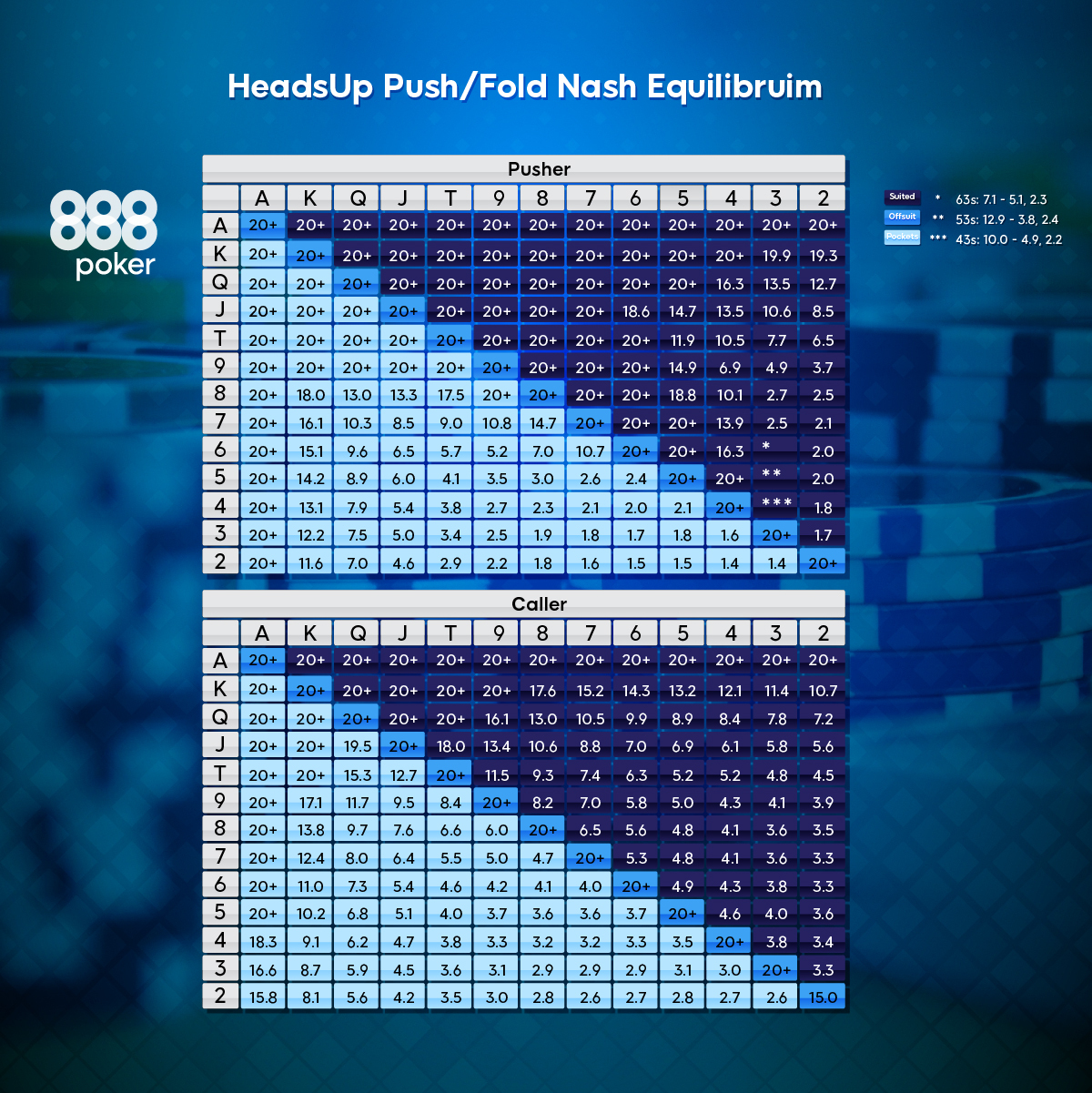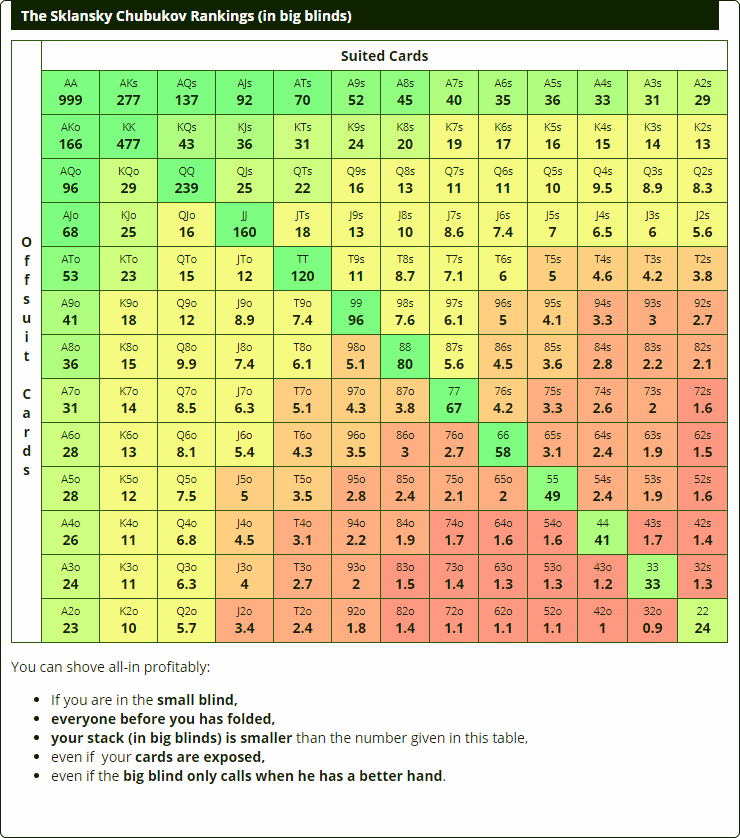Poker Shove Chart
The Rebound-Chart, when you are in the small blind Your Hand Early Pos. Cutoff Button AA - JJ 13 13 13 13 TT, 99 - 13 13 13 88, 77 - 7 13 13 66, 55 -5 8 AKs, AKo 13 13 13 13 AQs, AQo - 13 13 13 AJs, ATs - 7 13 13 AJo - 6 13 13 ATo, A9s - 4 8 10 A8s - A4s, A9o - A7o -4 6 KQs, KJs, KQo -4 6 The Rebound-Chart, when you are in. These Push Fold Charts will help you understand when you need to either fold or shove your entire stack when you are short stacked in poker tournaments. Please use these charts as a study tool to help you improve your understanding of push fold scenarios.
In the last Sit N Go article I discussed the role of ICM in SNG strategy. Another key part of SNG strategy as the tourney moves on into the middle and late stages is the Push/Fold Game.
What is the Push/Fold Game?
Push/fold strategy boils down to limiting your choices to either pushing all-in or folding your hand. This allows for maximum fold equity to pick-up the blinds and antes and makes it so you don’t commit some valuable chips pre-flop but then fold to post-flop pressure. You also get the added benefit of nice double-ups when your opp’s call you with inferior hands.
- When doing this, to account for the extra player that you’ll be shoving into (the player in the Small Blind), simply divide all the numbers in the chart by 2. If you have 95s on the Button and the action is folded to you, you can profitably shove, if you have a stack of 7.2bb or less.
- In that case, I would refer to the 10BB chart: If someone in front of you has already raised or shoved in, you should avoid conflict mostly. It takes a much better hand to call a shove than to make a shove. Look at the ten BB chart, you can defend with the three’s and often the two’s.
- Lost your password?
When to start the Push/Fold Game
The push/fold game starts once you reach the 50/100 and the 75/150 levels. Here, the 1,500 starting stack is only 10-15bb’s, and this is where many SNG players start their push/fold game. Everything you’ve learned up to this point has been geared to get you to this profitable spot. It’s profitable because your opponents call shoves too wide or don’t shove wide enough to pick-up the super important blinds and antes.
Pay attention to all showdowns and take note on your opponents regarding when they start their push/fold game and what they push with. Some begin early at sub-15bb’s. Others start super late at 7bb’s, and some never do it. Noting when they tend to push/fold will alert you to any changes in behavior, which could indicate hand strength. If you know that “9bb Norman” always pushes at 9bb’s or less, but suddenly at 7bb’s he min-opens, there’s a chance he’s got a nut hand and wants action. You can play him accordingly and give his unusual play the respect it deserves and fold out all but the best pre-flop hands.
(Of course, smart players can use this against you, so make note if you ever catch someone using a reverse tell like this.)
Why Use the Push/Fold Strategy
This is all about maximizing fold equity. When the blinds/antes are a big portion of your stack, you’ve got to do all you can to collect them.
If you’ve got a 1,500 chip starting stack, the 6 max blinds and antes at the 50/100 level could be 210 chips and collecting these adds 14% to your stack. At the 75/150 level? This would add up to 315 chips or 21% to your stack. Either of these are significant equity gains to your stack.
Pushing all-in maximizes your fold equity as only the strongest hands (or weakest players) will call for a big part of their stack, so we’ll be folding out most hands that would contend with a smaller raise of 2-3bb’s.
Another benefit of pushing all-in instead of making a smaller opening raise is that it doesn’t give our opponent the chance to re-raise all-in to put the pressure back on us. By shoving, we’ve put max pressure on our opponents and now the “ball’s in their court” as the saying goes.
Push/Fold Considerations
Your Hand
- The stronger your hand, the less fold equity you need; the weaker your hand the more you need.
- Try not to change your plays based on the strength of your hand. Like mentioned previously, perceptive opponents will notice when you deviate from your normal strategy and can change their plays based on your unusual actions.
Opponent Tendencies
- How likely will he fold? HUD stats and notes on opponents will tell you if he’s 90% likely to fold or only 70%.
- Against tight players (TAG’s and NIT’s) open up your range as much as possible
- Against loose callers (LAG’s, Fish and Donks) push a range that’s more value intensive (Aces are good for this as they’re less likely to have one if you do)
- Choose who you shove against wisely. Don’t jam wide vs wide callers.
Stack Sizes
- Pay attention to the stack sizes of those remaining in the SNG
- Big stacks call wider vs short-stacked shoves; fish call wider as well
- The bigger your stack in relation to theirs, the more pressure your shove puts on them
- Short stacks are much more likely to call than big stacks. They have lots to gain with the blinds/antes along with your bet, so they’ll call very wide.
- You have lots of fold equity vs similar sized stacks
- As a big stack put pressure on the medium sized stacks, especially when there’s a short stack or two in play near the bubble
- As a medium stack with a short stack or two in play, be more judicious in your choices to push all-in as you need to outlast these shorties.
Number of Players Remaining
- Players are less likely to call when on the bubble (OTB) because of the pressure of outlasting opponents to get into the money
- Jam wider OTB to build a big stack
- Make reads and take note of how your opponents play the bubble and just before the bubble
- Be careful that you know your opp’s and are making notes and reads to help you decide whether or not to shove.
Learning From Your Push/Fold Opportunities
As an SNG player, you’ll encounter the bubble and push/fold situations more times than you can shake a stick at.
As you play, tag hands where you have a push/fold decision and analyze them later in your HH review sessions. Use an ICM calculator (like ICMIZER or SNG EGT as discussed in the Middle-Stage SNG post). As you assign ranges to your opponents, make their ranges a little tighter when calculating their all-in shoves and wider when calculating their calling ranges. Being a bit more conservative on both fronts will slightly tighten you up, making your all-in ranges stronger.
The more you study these push/fold spots, the better innate understanding you’ll have of them which will help with profitable in-game decisions.
Push/Fold Charts
I mention using Push/Fold charts in the SNG Middle-Stage article, so please check that out, but I’ll make a quick mention of it here.
I used them in the past, but I found them to be a crutch and I would follow them overly-strictly and not even rely on opponent reads or the current game dynamic. I do recommend trying them, though, as many SNG players swear by them. Google “push fold charts” and try some for yourself.
Practice, Practice, Practice
The Push/Fold game isn’t something that anybody gets right off the bat. It takes time on and off the felt to work on this part of your game. Drop in stakes if you have to in order to get comfortable with shoving at around 10bb’s if you don’t yet do this. Tag hands and analyze them later, take notes on what you’ve learned, and put these into play in your next session.
Until next time, study smart, play much and make your next session the best one yet!
- The 12 Days of Christmas 2020 Podcast Episodes - December 14, 2020
- Strategies and Action Steps from the Quick Wins Poker Course - November 24, 2020
- How to Quickly Understand Online Tournament Players – Podcast #318 - November 18, 2020
The answer to this is a resounding Yes! We poker players absolutely have a range of hands we should be open-shoving with when short-stacked. In fact, this is one of the few areas of poker that is actually 'solved' by the math geeks of poker. The solution method derives from something called the Nash Equilibrium method.
In game theory, Nash equilibrium is a method of solving so-called 'non-cooperative games' (like poker) that involve two or more players. Nash assumes that each player is playing perfectly; i.e,. everyone knows the strategies and best decisions of the other players, and no player has anything to gain by changing only their own strategy unilaterally. Said another way: Hero and Villain are in Nash equilibrium if Hero is making the best decision he can, taking into account Villain's strategy, and Villain is making the best decision he can, taking into account Hero's strategy.
Uh, okay. What's this got to do short stack poker? Answer: the math boys have used this method to work out the chip-EV calculations for different hand ranges, given an assumed payout structure of an MTT, for different stack sizes and table sizes. The result of this is something called Push-Fold charts. Google/Bing/Yahoo the term and you'll find lots of information on this approach to short stack play. Or, even better, let Uncle Bug do it for you: Just go to a site like Exceptional Poker to get the charts. For instance, here's a chart for open-shoving when you're at 10 big blinds at a full ring table:
Poker Shove Fold Charts

If you were in MP with, say four players left to act, and the action folds to you and there are not yet Antes involved, you should be open shoving with: 22+ A7s+ A5s-A3s ATo+ K8s+ KJo+ Q8s+ QJo J8s+ T8s+ 98s. If you have a shorter stack than 10bb, just select the appropriate tab on the web page and go from there. Same with 6-max and heads-up play. (Note that if you have more than 10bb, you should be open-raising to less than all-in.)
Now, are the charts on a site like this perfect for all situations? No, of course not. The charts don't take into account things like individual villain traits and tendencies, and by default they have to assume a specific payout structure that may or may not match the tourney you're playing in (e.g., this particular web site assumes a very top-heavy payout structure). They also assume your opponents are playing perfectly and adjusting accordingly. This is clearly not true...
... but it turns out that this doesn't actually matter much. Most experts agree that if you use correct short-stack push-fold charts like the ones found on Exceptional Poker you will have a significant advantage over ~60% of the players you find at low and mid-stakes online tourneys, and probably a high as 70%+ in your local casino live low-stakes tourneys. Pay attention- this is a really significant edge, folks.
Poker Shove Charts
Poker Shove Call Chart
 Note that if you're new to push-fold Nash charts, you might think the hand ranges seem pretty wide. Well, yes, they are. But the math don't lie, and countless computer simulations by lots of smart poker/math guys have proven that these charts represent the game theory optimal solution and are correct.
Note that if you're new to push-fold Nash charts, you might think the hand ranges seem pretty wide. Well, yes, they are. But the math don't lie, and countless computer simulations by lots of smart poker/math guys have proven that these charts represent the game theory optimal solution and are correct.Note also that the Nash ranges assume you're up against opponents who play perfectly. When they make mistakes or don't play optimally, you profit even more by using the charts. Note however that if your opponent's mistakes are significantly large you can make even more profit by deviating your push/fold ranges from the chart. Usually this means tightening up a wee bit. But don't go too far, or you will be the one straying too far from Nash's recommendations-- and therefore be the one playing sub-optimally.
All-in for now...

-Bug